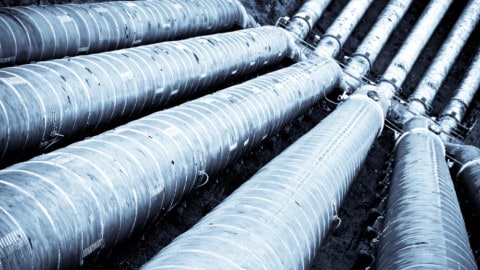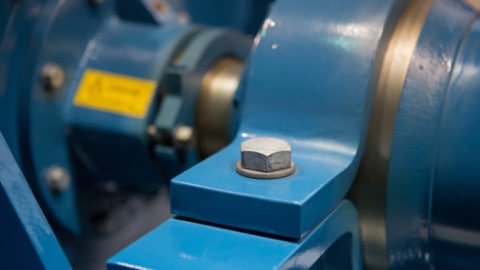Since the construction of the Ballarat South Wastewater Treatment Plant (BSWWTP) in 1925, the population of Ballarat has grown, compliance requirements have changed, and technologies have advanced. To keep up with these changes and to mitigate challenges associated with storm events, Central Highlands Water undertook a major upgrade of the plant, which involved the installation of new Archimedes screw pumps, and new coarse and fine screens.
BSWWTP is the primary wastewater treatment plant for the City of Ballarat, treating approximately 70 per cent of the Ballarat catchment – currently the equivalent population of 85,000 – with the other 30 per cent treated at Ballarat North Wastewater Treatment Plant.
Ballarat has been experiencing significant development and growth – primarily in the western corridor which is treated at BSWWTP – and the population is expected to continue to grow, with the BSWWTP expected to be servicing an equivalent population of 110,000 by 2035.
Furthermore, wet weather inflows to the plant have been historically challenging to manage. With storm events predicted to increase, combined with population growth, Central Highlands Water decided to upgrade BSWWTP to increase its capacity to allow it to better deal with wet weather events, and to ensure the plant’s ongoing sustainability.
The key aims of the upgrades were:
- Contribute to the sustainable treatment of wastewater, for the benefit of the environment and local community, and treat wet weather inflows to meet Environmental Protection Agency (EPA) licence conditions and General Environmental Duty (GED) obligations
- Increase the capacity of the inlet pumping station and inlet works to manage wet weather inflows
- Reduce potable water usage by constructing a new plant service water system for the inlet works and a new pipeline for the distribution of Class A equivalent recycled water
- Improve automation and decrease reliance on manual intervention when transitioning from normal dry weather to wet weather control modes
The wastewater treatment plant’s new screw pumps
The upgrade focused on inlet works, which was estimated to cost $9.2 million and came in under budget, at $7.5 million. This allowed for other complementary site improvement works to be funded, to further improve the efficiency and safety of the operations.
By maximising the capacity of the existing inlet works structure, Central Highlands Water was able to avoid building a replacement inlet works, as originally planned. The inlet works design, done by Jacobs Group, was able to increase the hydraulic capacity of the inlet works to provide a coarse screening capacity of 2,000L/s (up from 700L/s) and a minimum fine screening capacity of 1,200L/s.
It improved solids capture performance of the coarse and fine screens to approximately 70 per cent (up from approximately 30 per cent).
The project involved the installation of new Archimedes screw pumps and new coarse and fine screens to help filter out unwanted material from the wastewater, as it arrives at the treatment plant first before it makes its way through several additional treatment process steps.
“The screw pump is a technology more than 2,000 years old and is probably the most efficient technology for low head pumping,” a spokesperson for Central Highlands Water said. “The last upgrade of the inlet works was in the early 1990s, which included the installation of two smaller capacity epoxy coated mild steel Archimedes screws.
Over the last 30 years the screws had been periodically removed, one at a time, for maintenance and recoating and were at the end of asset life. “The two new STM1400 316 stainless steel Archimedes screw pumps were manufactured in the Netherlands by Spaans Babcock.
They are a selfsupporting unit supported on top and bottom bearings, inclined at 33 degrees, 1,400mm diameter, approximately 8m in length, and rotate at 42 rpm. “These pumps lift the influent 3.52m to provide hydraulic grade through the treatment process so that pumping in the downstream processes is minimised.
“The drive motors are 37kW, and the fabricated self-supporting trough ensures a perfect fit of the screw with a small tolerance between the screw and trough, which maximises the efficiency.” The screw pumps also have VSD inverter drives, with the speed varying to maintain a level setpoint in the inlet pump station.
“Central Highlands Water engaged Bureau Veritas to perform an inspection of the equipment once it was fabricated and tested before shipping from the Netherlands. This included all facets of the manufacture from compliance with drawings and tolerances, material composition, electrical certification,and welding,” a Central Highlands Water spokesperson said.
“Once the units arrived on-site they were inspected and treated for minor rust defects prior to installation, and full wet-commissioning was undertaken with recycled water prior to putting in service.”
The ongoing maintenance of the screw pumps involves inspection and maintenance of the screw pump body, the drive unit, and the upper and lower bearings. “The gap between the spiral blade and the trough is key to maintaining the pumping efficiency, so this is inspected quarterly.
The drive unit inspection and maintenance regime is typical for a motor and gearbox (noise, oil level, leakage, grease lines, etc.). The bearings are inspected for wear and tear, and alignment,” a Central Highlands Water spokesperson said.

Mitigating challenges
The inlet works were offline for approximately nine months, which required the project team to consider flow management and impact of providing no screening or grit removal on downstream processes.
“The northern and western sewers both discharge to the inlet works but fortunately a bypass channel around the inlet works already existed for the northern sewer. A new diversion structure was built over the western sewer to divert flows around the inlet works directly to the primary sediment tanks (PSTs).
Bypass pumping was entirely avoided during construction, by building the pit over the sewer and cutting out a pipe section using a wire saw,” a Central Highlands Water spokesperson said. “An automatic 30mm coarse screen was installed in the common channel to the PSTs.
This reduced handling and safety associated with manually raking the two existing trash screens during the upgrade works. Despite the reduced screening capacity, no significant downstream equipment issues were experienced while the inlet works were offline.”
3D point cloud and models were also prepared for all new works by designers, who were based interstate. The use of the 3D models significantly improved operator engagement and the elimination of OH&S risks through visual representation. Great consideration was also needed to reduce the risk of delays.
“The tender for the project was released in December 2019, prior to the outbreak of COVID-19 later that month. With the progression of transmission, and subsequent travel restrictions imposed, there was a great deal of consideration put into managing the risks for delays and likely impositions before awarding the contract to head contractor Guidera O’Connor in June2020,” a Central Highlands Water spokesperson said.
“As there was a long lead time involved with procurement of the screw pumps and screening equipment, the design inputs for these were essential to obtain quickly. The use of 3D surveying and video conferencing enabled the contractor’s design team to engage with the operators and quickly and efficiently resolve the design and place orders. This then reduced the time risk for the period between the equipment landing on-site and the mobilisation of the work team to site.

New pump station and pipeline to transfer water
A new pumping station and pipeline were also constructed as part of the upgrade to transfer recycled water to the inlet works. This is used as service water to clean screens within the wastewater treatment plant, and enhances water recycling efficiency to the operations by reducing the demand on potable water use at the plant.
These works involved replacing existing recycled water pumps and installing a new pipeline to transfer recycled water to the solids dewatering process. “Potable water usage at the site has been reduced with service water demand being met by Class B recycled water and filtered tertiary lagoon water which is supplied to the inlet works, saving approximately 400kL of potable water use per day,” a Central Highlands Water spokesperson said.
“A new pipeline was constructed from the Class B booster pumps to the dewatering, digester and primary sedimentation with a new pump skid installed with three CRNE 20-6 Grundfos pumps running in parallel. The pumps are configured to operate in a duty/duty/assist configuration, depending on the water demand required, and the overall capacity of the system is 25L/s.
“A new service water pipeline has also been constructed, taking secondary clarified effluent from the lagoon system and pumping it to the inlet works. Effluent is filtered to remove particulates using a 100μm AMIAD filter to comply with the inlet works screening equipment manufacturer’s water quality requirements in order to prevent the spray nozzles on the band screens and washer/compactors from blocking.”
Upcoming projects at BSWWTP include upgrading and refurbishment of critical process units such as the primary sedimentation tanks and mechanisms, the dewatering process facility, and augmenting aeration capacity.
Continuing to improve services to the region
The inlet works are part of Central Highlands Water’s top ten priority projects for the 2018 to 2023 period. Additional ongoing and/or planned capital works project being undertaken, include:
- Ballarat Sewer Growth Project – Ballarat West
- Ballarat Sewer Build – Ballarat East Trunk Sewer (Stage 2)
- White Swan Dam Safety Improvement
- Digital Water Metering
- Ballarat North Growth Project – Northern Growth Area
- Ballarat Sewer Build – Ballarat South Outfall Project
- Regional Recycled Water Scheme Upgrades
- Daylesford Water Treatment Upgrade
- Daylesford Raw Water Pipeline
- Ballarat Sewer Growth Project – Northern Growth Area



















